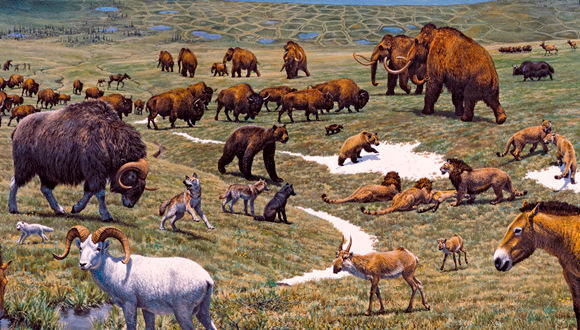Why were mammoths and other megaherbivores so big?
According to a study Josep Peñuelas has published in Nature Ecology & Evolution, the size of herbivorous megafauna was crucial to their survival in a cold, dry, largely barren environment. The study's data were obtained by incorporating the hugely significant effect of herbivores into innovative mathematical models capable of simulating landscape evolution.

A study published today in Nature Ecology & Evolution concludes that the mammoths and other large herbivores which inhabited the tundras and steppes of central Europe survived thanks to their colossal size. “Being big wasn't just an advantage, it was a necessity”, explains Josep Peñuelas, a CSIC researcher based at CREAF and one of the study's co-authors. “They needed to be huge to survive the harsh conditions”, he emphasizes.
Mathematics has revealed that, before humans drove them to extinction, such animals' size was the key to their success. The larger they were, the lower their metabolic rate and the more efficient their use of energy was, and the more food they were able to eat and digest, due in part to their intestine being bigger.
When such animals searched for food, their massive paws disturbed the snow and destroyed carpets of moss. As a result, fresh grass grew up more quickly and in much greater quantities.
In the last glacial period (from 110,000 to 10,000 years BC), Europe's tundras and steppes were populated by vast numbers of herbivorous animals, many of which would have dwarfed their modern-day counterparts. Examples include giant horses and the woolly rhinoceros, as well as mammoths, which, in the case of Mammuthus trogontherii, could weigh as much as 10 metric tons and have a shoulder height of up to 5 metres (African elephants pale in comparison, at ‘just’ 6 metric tons and 3.5 metres).
Bearing in mind that very little vegetation other than moss and grass grew in the habitats in question, how could this harsh, cold, dry terrain sustain such an immense population of herbivores, some of which were enormous? “Our study has solved that paradox”, says Peñuelas. “The last glacial period's herbivores had attained an ideal size, thanks to which they were able to eat grass in great quantities and expend the smallest amount of energy possible”, he explains, before pointing out that “the nature of the vegetation was partly due to the impact of the large herbivores, which reduced tree cover and increased grazing land”.
The study's researchers arrived at their conclusions by incorporating the vital role of large herbivores, a variable rarely considered to date, into mathematical models for simulating vegetation regrowth.
Extinct and endangered large herbivores
The researchers tested the mathematical model through which they unlocked the secrets of the past by applying it to today's large herbivores. Their results show that there might be almost twice as many large herbivores roaming the Earth as there are at present had humans not altered the way land is used, by destroying habitats to build towns and cities or by planting crops on grazing land, for instance. The finding in question is particularly significant given that almost 60% of extant large herbivores are in danger of extinction (elephants, rhinoceroses, gorillas, etc.).
REFERENCED ARTICLE:
Dan Zhu, Philippe Ciais, Jinfeng Chang, Gerhard Krinner, Shushi Peng, Nicolas Viovy, Josep Peñuelas and Sergey Zimov. The large mean body size of mammalian herbívores explanis the productivity paradox during the last glacial màximum. Ecology and Evolutions. DOI http://dx.doi.org/10.1038/s41559-018-0481-y







